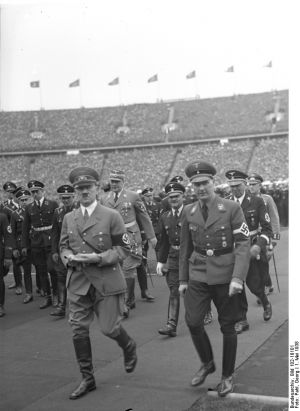Baldur Von Schirach

Hitler and Von Schirach at a Nazi Party Rally
Baldur von Schirach was born in Berlin on the 9 March 1907, the son of an aristocratic German father and an American mother whose ancestors included two signatories of the Declaration of Independence.On his father’s side descended from an officers’ family with artistic tendencies and a cosmopolitan background, Baldur grew up in a pampered, well-
Von Schirach became a convinced anti-
In 1933 he organised the gigantic youth march in Potsdam, in which wave upon wave of youngsters greeted Hitler. Already before the Nazi seizure of power, von Schirach ceaseless propaganda, his idealism and organisational flair for mobilising youth had succeeded in winning over hundreds of thousands of young Germans to Hitler’s cause. In May 1933 he was made Leader of the Youth of the German Reich at the age of twenty-
Von Schirach taught German youth that their blood was better than that of any nation and devoted his lyricism to hollow worship of the Fuhrer’s genius. Towards the outbreak of the Second World War, his position was being undermined by the intrigues of Martin Bormann and other enemies. Jokes about his effeminate behaviour and his allegedly white bedroom furnished in a girlish manner, were legion and he was never quite able to live up to his own ideal type of the hard, tough quick Hitler youth.
At the beginning of 1940, von Schirach enlisted as a volunteer in the German army, serving in France for a few months as an infantry officer and receiving the Iron Cross – Second Class. Then after being relieved of his post as Leader of the Hitler Youth, von Schirach was appointed Gauleiter and Governor of Vienna in August 1940. His unorthodox cultural policies in Austria soon aroused Hitler’s distrust, with promptings from Bormann, and after a visit to the Berghof in 1943, where he pleaded for a more moderate treatment of the eastern European peoples and criticised the conditions in which Jews were being deported, he lost all real influence. Nevertheless, he was on record in a speech on the 15 September 1942 as saying that the “removal” of Jews to the East would “contribute” to European culture.”
The deportation of 65,000 Jews from Vienna to Poland during his tenure as Governor was a major indictment against von Schirach at the Nuremberg trials. The war crimes tribunal conceded that he did not originate the policy but had participated in the deportations from Vienna, though he knew that the best the Jews could hope for was a miserable existence in the ghetto’s in the East. Von Schirach admitted that he had approved the “resettlement” but denied all knowledge of genocide, denouncing Hitler from the dock as a “million –fold murderer,” and calling Auschwitz “the most devilish mass murder in history.”
Von Schirach was sentenced on the 1 October 1946 to twenty years imprisonment for crimes against humanity – which he served out in the company of Rudolf Hess and Albert Speer in Spandau prison. The handsome, fair-
Sources:
Robert S Wistrich, Who’s Who in Nazi Germany, Routledge, London 1995
Charles Hamilton, Leaders and Personalities of the Third Reich, R. James Bender 1984
© Holocaust Historical Society 2014

